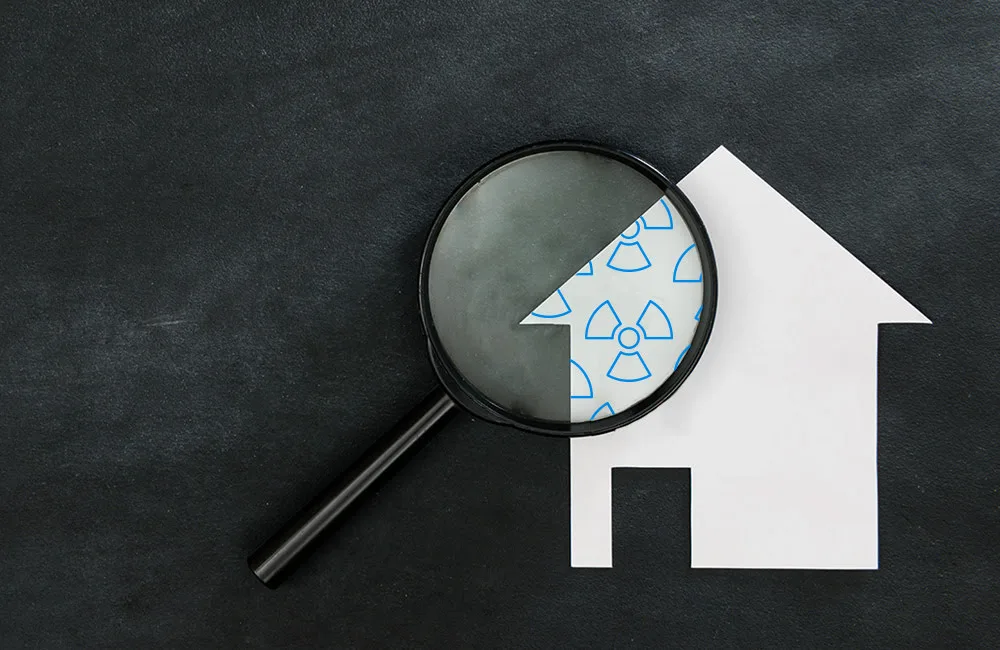Stay Safe in the Rockies: Radon Testing and Mitigation in Colorado
The Rocky Mountains are known for their majestic peaks, crisp mountain air, and abundance of outdoor activities. However, something invisible lurks in many Colorado homes that can put your health at risk – radon gas. As a leading cause of lung cancer among non-smokers, radon deserves your attention. By understanding radon risks, testing your home, and mitigating elevated levels, you can breathe easier in the state’s famed fresh mountain air.
What is Radon?
Radon is a radioactive gas that occurs naturally from the breakdown of uranium in soil, rock, and water. As a gas, it seeps into buildings through cracks and openings in foundations. Radon itself is invisible, odorless, and tasteless, so the only way to know if dangerous levels are present is through testing. Prolonged radon exposure is the second leading cause of lung cancer in the United States after smoking. The Surgeon General and EPA estimate that radon causes over 20,000 lung cancer deaths per year.
Unlike some environmental hazards, radon is easily addressed through established mitigation techniques once identified. Widespread radon testing in Colorado and mitigation could prevent many of these lung cancer deaths. The EPA and public health organizations recommend testing all homes for radon.
Why is Radon a Concern in Colorado?
Several factors put Colorado at particular risk from radon compared to other parts of the country:
- Geology: Colorado sits atop uranium-rich soil and bedrock, providing a ready source of radon. Granite, shale, and volcanic rock are especially high in uranium. All of these geological formations are common in Colorado’s Rocky Mountains and foothills.
- ** Soil permeability:** The rocky, porous soil throughout much of Colorado allows radon to rise up through cracks in foundations. Tightly packed or clay-based soil impedes radon movement.
- Housing stock: With a dry climate, houses in Colorado tend to be less airtight than other regions. This allows radon entry points. Crawl spaces and openings in concrete slabs found in many Colorado homes enable radon to accumulate.
- High elevation: Low air pressure and thinner atmosphere at high elevations facilitate the movement of gases like radon. Much of Colorado’s populated areas sit above 5,000 feet.
These conditions make radon far more prevalent in Colorado homes than most other states. Nationwide, the EPA estimates about 1 in 15 homes have elevated radon levels above 4 pCi/L. In Colorado, about 6 in 10 homes are estimated to be above this level based on limited state testing data.
Health Risks from Radon Exposure
Radon health risks come from inhaling the radioactive gas and its decay particles, which exposes the lungs to ionizing radiation. Long-term radon inhalation leads to genetic damage that can cause lung cancer. Radon accounts for about 21,000 of the estimated 30,000 lung cancer deaths yearly among non-smokers in the U.S.
Like smoking, radon exposure and lung cancer risk are cumulative over a lifetime. However, unlike smoking where health risks drop after quitting, radon keeps decaying and exposing lungs to radiation as time goes on. Adding radon and smoking together increases lung cancer risks even further.
Any amount of radon carries some degree of health risk. However, the EPA and other health organizations base radon recommendations on evidence that lung cancer risk remains low with long-term exposure below 4 pCi/L, but rises sharply above that threshold. There is no known safe level of radon since health risks start at any concentration. Yet the clear jump in lung cancer rates from radon at 4 pCi/L and above led to establishing this as an action level.
When Should You Test for Radon in Colorado?
Health agencies including the EPA, American Lung Association, and American Medical Association unanimously agree that all homes should be tested for radon. Even new homes should be checked, since they can also let in radon over time.
Radon testing in Colorado is straightforward and inexpensive. Given the health hazards, radon tests are among the most valuable steps you can take to protect your home and family. Consider testing if you have not done so already or have made major renovations. Key times to test your home for radon include:
- Before buying a home
- After moving into a new residence
- After making energy retrofits or major home repairs
- Every 5-10 years to detect new radon entry points
- Anytime radon levels are mitigated – retest within a few years
Keep in mind that radon levels can vary seasonally, between rooms, and day to day. For a clear understanding of your home’s average radon level, experts recommend conducting multiple tests over at least 3 months. Avoid single short-term tests when possible. However, even short tests will indicate if you have a potential problem and need follow-up long-term monitoring.
Radon Testing Options
Several types of easy-to-find radon test kits are available from home improvement stores, online retailers, and state health agencies:
- Short-term test kits: These passive detectors get exposed to the air for 2-7 days, then get sent to a lab for analysis. Short-term kits are a quick way to determine if high radon is likely. Follow up with long-term testing if results are at or above 4 pCi/L.
- Long-term test kits: Used for 3-12 month periods, these provide a reading that reflects typical household radon levels over time. Long-term passive detectors are more accurate than short-term tests.
- Active monitors: Electronic radon monitors plug in and read levels continuously. Active monitors can detect changes and fluctuations. They are pricier but give the most complete radon data.
Where you place the radon detectors is important to get meaningful results:
- Test in lowest lived-in areas of the home like basements. Radon settles and concentrates at lower levels.
- Place detectors 20-39 inches off the floor in a spot where it won’t get disturbed or direct sunlight.
- For a complete house assessment, use multiple monitors at different locations and on every floor.
Always carefully follow the test kit instructions for proper use and placement. Report final radon readings and testing conditions fully and accurately. Qualified radon professionals can also perform or assist with testing. Once you know your radon levels, you can make informed decisions about mitigation if needed.
What to Do if You Have High Radon
The Environmental Protection Agency (EPA) sets the action level for indoor radon at 4 pCi/L or higher based on health risk data. At or above this level, the EPA and health organizations recommend taking steps to lower radon in your home through mitigation.
Here are the general guidelines based on radon test results:
- Under 2 pCi/L – No action required. Retest every 5-10 years.
- Between 2-4 pCi/L – Consider fixing between 2-4 pCi/L. Retest at least every 2 years.
- 4 pCi/L or higher – Mitigate the home within 1-2 years. Retest after fixing.
- 10 pCi/L or higher – Fix within weeks to lower lung cancer risk. Retest after mitigating.
Keep your home’s test records since real estate transactions and major renovations usually require disclosure and possibly follow-up testing.
The only way to know if mitigation effectively reduced radon is to retest your home afterwards. Make sure levels fall below 4 pCi/L. Continue periodic retesting even after successful mitigation every 5-10 years.
Radon Mitigation Strategies
When your house has high radon, proven techniques can lower levels. Radon mitigation involves:
- Assessing how radon gets in by a certified professional
- Installing a system to vent radon from below your home’s foundation
- Sealing openings that allow radon entry
The two main radon mitigation methods are:
Sub-slab suction: Pipes and a fan extract radon from beneath concrete slab foundations before it enters your home. This is the most common strategy.
Sub-membrane suction: Similar system but for homes with crawl spaces. Pipes under plastic sheeting draw out radon.
In most cases, radon mitigation effectively cuts levels by 80-99%. This significantly lowers your lung cancer risk by getting radon below 2 pCi/L or as close as possible to outdoor background levels. Radon professionals focus on these best practices for effective, long-lasting mitigation:
- Installing PVC pipes, with joints caulked, in the layer of rock and soil beneath foundation
- Using an in-line or roof-mounted fan to maintain suction under the foundation
- Sealing and weatherizing foundation cracks and openings
- Installing a warning device to indicate any future system failure
- Providing ongoing system maintenance and retesting
The average radon mitigation system costs $1,200-$2,500 in Colorado, although prices vary by home size and scope of work. Most homeowners recoup costs in 5-10 years through increased home value and energy savings from weatherizing. Radon reduction is also a worthwhile investment in your family’s health.
Finding a Certified Radon Mitigation Contractor
A qualified radon mitigation professional is key to properly lowering high levels in your home. The American Association of Radon Scientists and Technologists (AARST) recommends selecting an AARST-listed National Radon Proficiency Program (NRPP) certified radon mitigator.
These certified radon contractors have proper training, demonstrated expertise, and continue their radon education. They follow strict radon industry standards and ethics requirements. NRPP mitigators provide warranties and are the most qualified to effectively address high home radon.
Get at least 3 quotes and ask these questions when choosing your radon mitigation contractor:
- Are they NRPP certified?
- How many years experience with radon mitigation?
- Will they install to AARST standards and mitigate to under 2 pCi/L?
- Do they offer warranties on parts and labor?
- Can they explain what the system will do and costs upfront?
Be wary of radon companies that use high pressure sales tactics, require full payment upfront, or lack certified technicians. Protect yourself with a contract that outlines everything the mitigation company will provide.
Living Safely with Radon in Colorado
With elevated radon levels prevalent in Colorado homes, every resident should test and fix high radon. This important step protects your household from long-term lung cancer risks. By understanding radon risks, testing your home, and mitigating high levels, you can rest easy breathing the state’s fresh mountain air for years to come.
Act now to determine your home’s radon situation so you can take action if necessary. Contact a certified radon testing in Colorado professional to get started. Various grants, cost assistance programs, and radon-resistant building codes also help address this preventable health hazard across Colorado.
Empower yourself with information about radon risks, testing, and mitigation from reliable public health resources such as:
- Colorado Department of Public Health and Environment
- American Lung Association
- Environmental Protection Agency
- American Association of Radon Scientists and Technologists
Knowing your home’s radon levels means you can make informed decisions about your family’s health. Don’t become a lung cancer statistic. Join public health efforts to test and lower radon across Colorado’s iconic Rocky Mountains and ensure healthy air.







